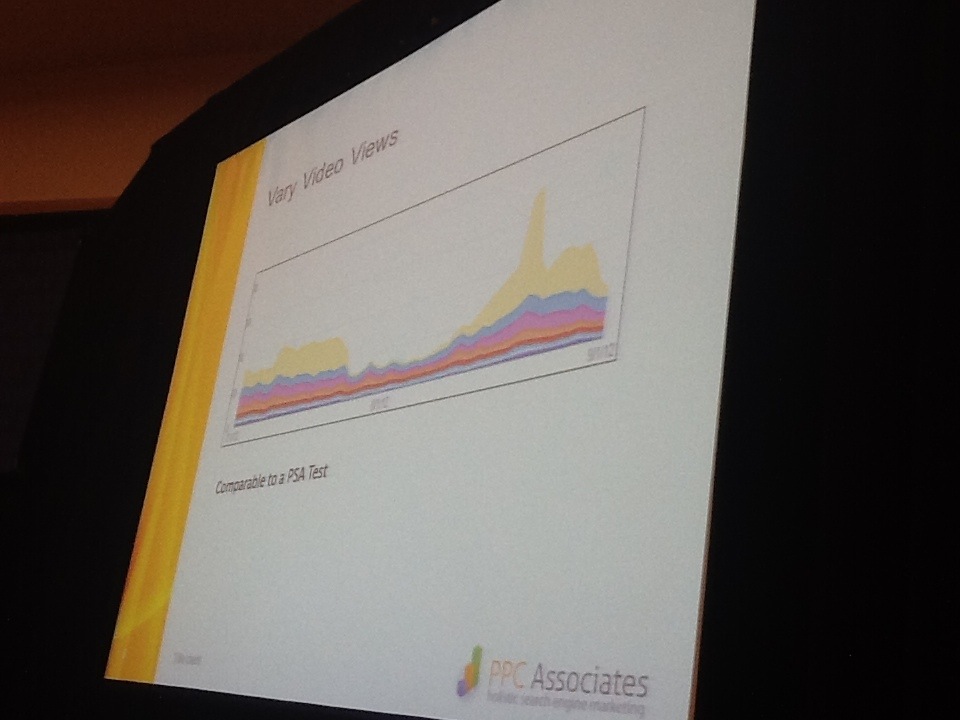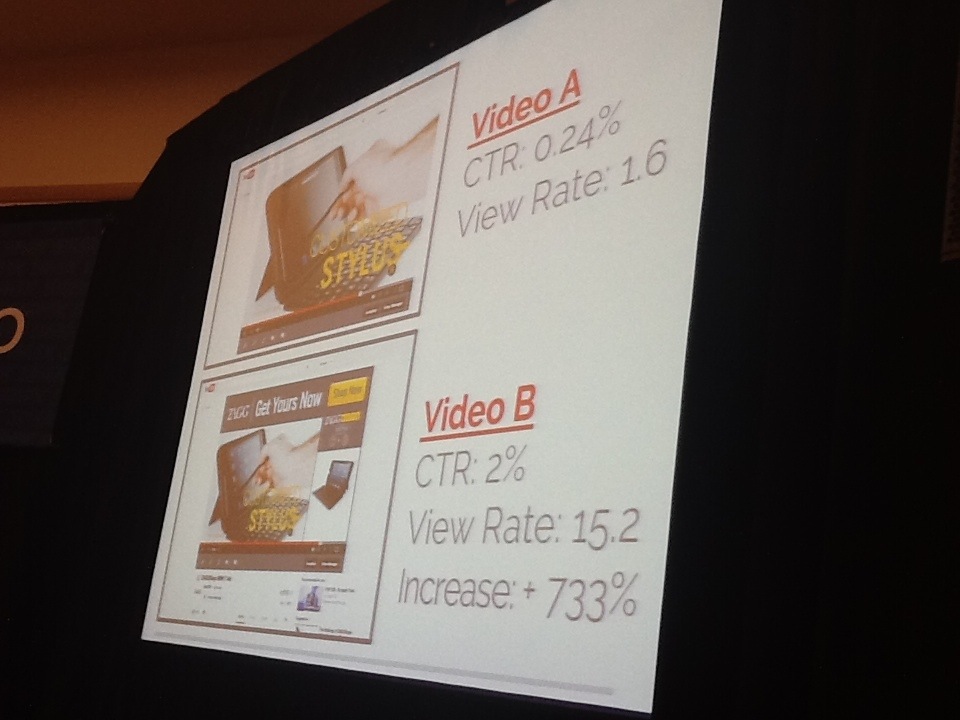YouTube Words: Tying Your PPC Campaigns To YouTube #32C
 |
Purna Virji @punavirji heads search marketing for an e-commerce company. Why do we love YouTube? She plays a video of a news segment where a news guy is seeing a Texas rat snake and gets scared and jumps away. Everyone laughs, I scream (out loud…).
There’s a myth that YouTube is a branding tool. Not true – as direct response advertisers they make “a killing”. There are 3 types of TrueView ads (inslate, instream, indisplay) and she’s just going to focus on indisplay. Indisplay ads show up on the side of videos that pay across the content network. You’re only charged when someone selects to play your ad. She studied the types of Trueview ads and found in-search and in-display were the winners. After the initial ramp-up the campaign is low maintenance.
Step 1: pick the right video. Leave 15-30 second videos for in-search, and here do 2-14 minutes. Check YouTube Insights for views, engagement, mobile stats. Add related videos and don’t be a one-hit wonder.
Related video ideas: testimonials, product details, humor. Use your blog posts, see FAQs, turn infographics into videos. Portent has a content idea generator that might give you an idea.
Step 2: optimizing your channel page. If you have a slightly higher spend on YouTube paid search, apply for a custom channel. It gives you custom images, content accessibility filters and enhanced tracking capabilities. Contact your Google rep for this, but it won’t be available to everyone since there are spend requirements.
YouTube One Channel is an alternative and anyone can set one up. It encourages subscriptions. There are flexible design options and incredibly easy to customize.
MVPs for conversion rate:
clear calls to action
free banner ad
Step 3: selecting the right keywords. YouTube is higher up on the sales funnel so go with broader keywords. Use the YouTube keyword tool.
Step 4: creating effective ads. Think like paid search. Setup ad groups tightly. Choose the thumbnail image wisely, it helps with CTR. When choosing destination page she recommends to always choose channel page.
Step 5: leveraging annotations. Add annotation button, choose style, perfect it with colors and fonts and you’re done. You can have it show up as a call to action in the video itself – note only links to other videos in the video are clickable, so use vanity URLs. You can apply for external annotations! (This is treated like a secret.)
Trick to drive clicks to related videos: have existing video play for a few more seconds with a white background and change annotation for related videos.
Step 6: building trust. Set aside 20 minutes each day for YouTube community management.
Step 7: continued optimization.
- Thumbnail
- Ad copy
- Channel banner
- Annotations
- Video versions (maybe tweak beginning if drop off early)
- Landing page
- Channel design
Ron Fusco is our next speaker. Video views and other marketing channels in general drive brand awareness, which tends to be more difficult to measure. You control the impressions, targets, location and volume easily. The easiest way to find and measure brand awareness is through paid search. Searching for brand is interest in brand.
Vary video views, and it’s comparable to a public service announcement test – turn it off for time and know the time you’re alternating. You need volume for this to have an impact.
Then crunch the data in Excel, he suggests with scatter plots.
YouTube search is still search. People search a little differently, more how-to, consume content, but still intent there so you want to stay relevant. Make sure your copy is relevant and treat your video page like your landing page. Don’t sell your product, sell the content.
YouTube remarketing is one of the coolest things about AdWords for video. Every video you have, Google builds a list of who’s watching it. You can play with these lists, target Google Display Network with regular advertising. These are people who have engaged with content, they’re still upper funnel but they have an understanding of what the brand’s about. You can also remarket with video. Say a user’s been to your site and didn’t convert. Maybe a banner isn’t right to move them down the funnel, so try a video to bring them back to the funnel and work them down.
Link the YouTube account to AdWords. You get engagement metrics inside the UI so you don’t have to step outside to GA You also get call to action overlay when you do this – outside links in annotations. And accounts must be linked in order for YouTube to build up a remarketing list. Multiple YouTube accounts can link to one GA account.
Creating lists is a place to get creative. You’ll see many list types, divided by how they interacted with your content on YouTube. You can overlay YouTube lists. In AdWords he’s found contextual targeting works the best for direct response. You can overlay YouTube lists with contextual targeting and you get a highly engaged audience.
Call to action overlays are clickable and can link to your site. You don’t need a Google rep for this, anyone can do it free.
Jake Larsen @jakelarsen7 (see my interview with Jake Larsen from last week for some in-depth knowledge share) asks how many people are already using Trueview and wants to know why some people want to try it but maybe haven’t yet. YouTube changed their layout this week and channel banner will be phased out.
Trueview lets you get super targeted with your audience, interest of person, topics of content of page and you can combine the two. You can also target keywords. Remarketing is where they’ve seen their most success. You can remarket from your channel or remarket your channel. You can also target by placement, which works if you separate channels. YouTube gives you target predictions – he doesn’t know how accurate that is.
7 TrueView tips:
1. Build the video around the click. What’s a view? Half the ad or 30 seconds. How much does it cost? You get charged per view, not per click. If you can get someone to click the screen, in takes them to your landing page and pauses the video. That click doesn’t cost you if you get them to click before the 30 seconds is up!
2. Have a good landing page that converts well. This is half the battle.
3. Be interesting. With TrueView the viewer can skip the ad after 5 seconds. If you don’t have their attention after 5 seconds they don’t want what you’re offering – that’s not necessarily a bad thing.
4. Experiment.
5. Retarget.
6. Be clear. This is who I am. This is what I do. This is what you need to do.
7. Measure everything.
26,000+ professionals, marketers and SEOs read the Bruce Clay Blog
Subscribe now for free to get:
- Expert SEO insights from the "Father of SEO."
- Proven SEO strategies to optimize website performance.
- SEO advice to earn more website traffic, higher search ranking and increased revenue.

LEAVE A REPLY











